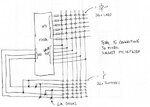Garry34
Newbie level 3
- Joined
- Jun 19, 2011
- Messages
- 3
- Helped
- 0
- Reputation
- 0
- Reaction score
- 0
- Trophy points
- 1,281
- Location
- Upwey, Victoria, Australia
- Activity points
- 1,315
Howdy guys,
I am not sure I am doing this correctly, in the right place, or even if my question is dumb, but here is my problem. I work part-time travelling to schools doing lectures on the archaeology and history of the ancient world; I transport a travelling exhibition of artefacts, replicas, and models with me.
I am building a new archaeological showcase to take to schools and in it is a sculpted 3D model of the Valley of the Kings in Egypt. At the location of each Egyptian tomb is a red LED.
My idea is this: using a 9V battery and a row of press-button switches each labelled with the name of an individual (Pharaoh or other individual) buried in the Valley of the Kings, I wish students to be able to press a switch and the appropriate LED to light up for say 20 seconds or so and then switch OFF.
If another button is pressed while any LED is ON it should switch the lit LED OFF immediately and the new LED light up with the timing restarting. The CCT should draw minimal (or preferably zero) current when all LEDs are OFF to conserve battery power supplied by a 9V battery. How can I do this with a minimum of components and minimum current drain?
Perhaps one of you guys could propose a CCT for my addled brain? There are 36 LEDs on the model.
Thank you,
Garry
I am not sure I am doing this correctly, in the right place, or even if my question is dumb, but here is my problem. I work part-time travelling to schools doing lectures on the archaeology and history of the ancient world; I transport a travelling exhibition of artefacts, replicas, and models with me.
I am building a new archaeological showcase to take to schools and in it is a sculpted 3D model of the Valley of the Kings in Egypt. At the location of each Egyptian tomb is a red LED.
My idea is this: using a 9V battery and a row of press-button switches each labelled with the name of an individual (Pharaoh or other individual) buried in the Valley of the Kings, I wish students to be able to press a switch and the appropriate LED to light up for say 20 seconds or so and then switch OFF.
If another button is pressed while any LED is ON it should switch the lit LED OFF immediately and the new LED light up with the timing restarting. The CCT should draw minimal (or preferably zero) current when all LEDs are OFF to conserve battery power supplied by a 9V battery. How can I do this with a minimum of components and minimum current drain?
Perhaps one of you guys could propose a CCT for my addled brain? There are 36 LEDs on the model.
Thank you,
Garry


